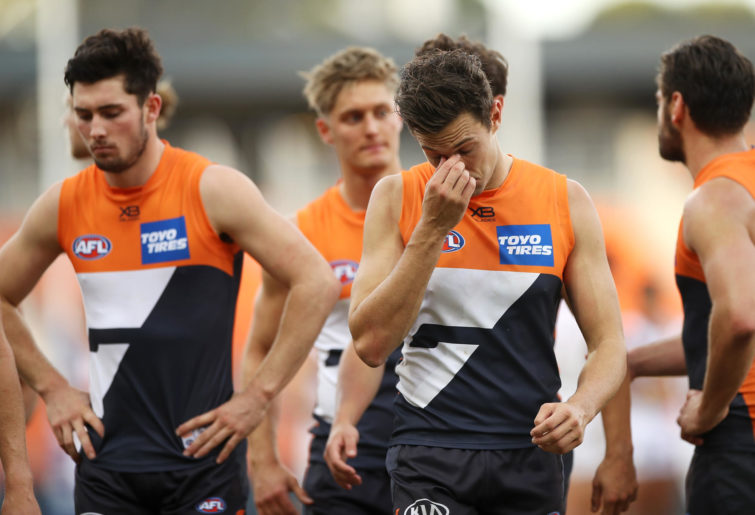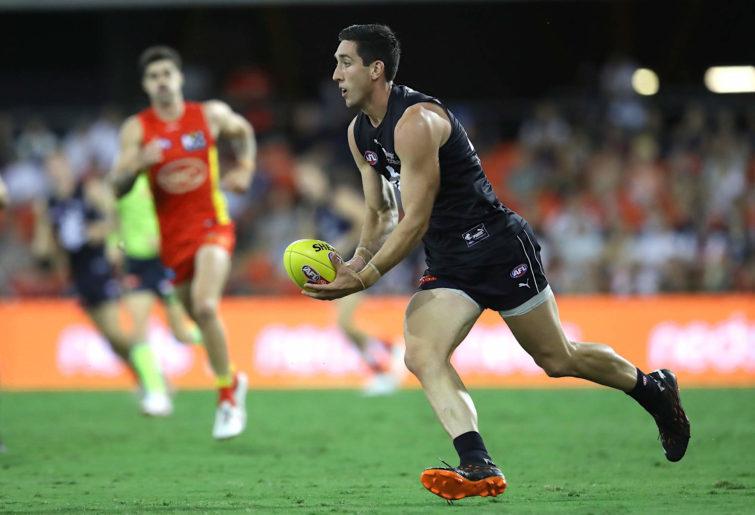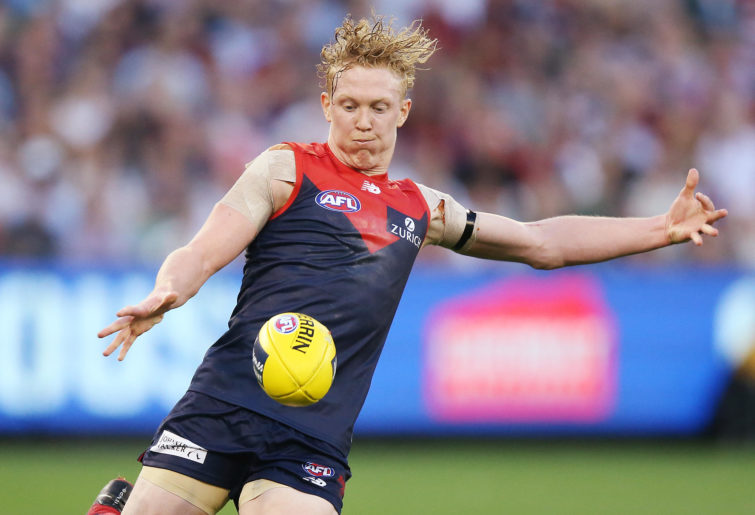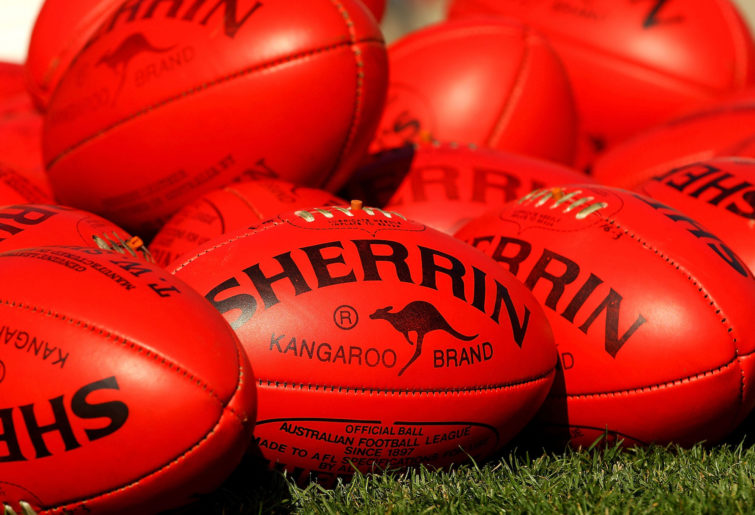Roar Rookie
Opinion
This article is dedicated to the exploration of how the free market and consensus governance can be applied to Australian football to help it grow, become more dynamic and become more accessible to all Australians and potentially the world.
The AFL’s revenue is $793 million (pre-COVID), yet they only distribute $314 million to the clubs. Where is all the money going?
The divisional model proposed is inspired by the European football model, rather than the American NFL fixed-license system.
In regard to the hypothetical team table below, I have not included SANFL or WAFL teams, as those leagues are operating well. However, if say a Norwood or a Subiaco can demonstrate sustainability as a participant, then they are welcome to enter the league from the lowest division, pending 51 per cent consensus from participating clubs. This applies to any international or domestic clubs also willing to join the league.
Details regarding the constitution, governance, player transfers and distribution rights are mentioned below the divisional tables.
The 12-side-per-division model attempts to blur the line between the Division 1 and Division 2 to maintain audiences and revenue, while also appealing to our traditional formula of 12 teams, 22 rounds, where each side plays each other twice. Twelve teams per division would also ensure closer contested games, as the gap between first and 12th is less than first and 18th.
The battle for relegation would also be seriously dramatic, enthralling supporters no matter where they sit on the ladder, resulting in increased revenues.
The alternative is to have 18 teams and three divisions, however there is something more elegant, pure and intense about 12 teams per division, and it keeps Division 2 intrinsically connected to Division 1 broadcast rights. Division 4 stretches out to a maximum cap of 23 teams.
Based on predicted future strength of the clubs (real and hypothetical), the divisional table below could represent what the league table could look like in 2050.
Division 1
12 teams, one premier, five finalists, two relegation spots
Richmond Tigers
Essendon Bombers
Adelaide Crows
West Coast Eagles
Collingwood Magpies
Sydney Swans
Carlton Blues
Brisbane Lions
Melbourne Demons
Fremantle Dockers
Geelong Cats
*Los Angeles – privateer
Division 2
12 teams, one premier, five finalists, two relegation spots, two promotion spots
Hobart Pirates
Western Bulldogs
St Kilda Saints
Canberra Federals
GWS Giants
*Las Vegas – privateer
*London FC – privateer
Perth United
Port Adelaide Power
Hawthorn Hawks
Gold Coast Suns
*Ireland Fighters – AFL-sponsored

(Photo by Mark Kolbe/Getty Images)
Division 3
12 teams, one premier, five finalists, four relegation spots, two promotion spots
Darwin Crocs
*Seattle/third US Team – privateer
Launceston Devils
Cairns Reefers – privateer
North Melbourne Kangaroos
Bendigo Pioneers
Fitzroy FC
Ballarat United
*Tokyo – privateer
Werribee Tigers
Sunshine Coast – Brisbane reserves
Bunbury – Fremantle reserves
Division 4
24 teams, one premier, eight finalists, no relegation spots, four promotion spots
Southport Sharks
Alice Springs All Stars – NIAA government-funded
Albury Wodonga
Gippsland Power – Melbourne reserves – Traralgon
Northern Rivers – GC reserves – Lismore
*Auckland – privateer
*Cape Town – privateer
Aspley Hornets
*Port Moresby – government
Shepparton United
Wagga Wagga – Canberra reserves
Port Melbourne Boroughs
Bayside Dolphins – St Kilda Reserves – Frankston Oval
Central Coast – Sydney reserves – Newcastle/Gosford
Mildura Murrays
Wollongong – GWS reserves
Richmond reserves
*Fiji – Suva – FNPF-funded
Essendon reserves
Collingwood reserves
Warrnambool – Geelong reserves
Horsham – Bulldogs reserves
Carlton reserves
Geraldton Dingoes
The teams listed are suggestion only.
The code shall be underpinned by a footy constitution currently under development. The laws of the game would be enshrined in a national trust, with rule changes only to be amended by 75 per cent consensus of participating clubs.

(Photo by Michael Willson/AFL Photos via Getty Images)
Governance is via 51 per cent club consensus.
• Governance by participating clubs, based on democratic consensus, with the AFL acting as administrator
• Two clubs to be promoted and/or relegated from each division
• No draft. Players will choose who they wish to play for
• No salary cap, although dependant upon club consensus
• Player/club transfer fees act as a key factor in supporting junior footy development, and revenue streams for smaller feeder clubs
• Final five series offering a distinct advantage to top spot
• Unlimited player list sizes
• Richer clubs may choose to field a stand-alone reserves side and even junior development squads, but there is no rules on reserves players, who they play for or where supplementary players can be sourced from
• All clubs are responsible for their own revenue and welfare. Financial dispensation is dependent on 51 per cent club consensus
• Season fixture and broadcast rights to be negotiated via the clubs, broadcasters and ground representatives, based on 51 per cent consensus of clubs (per division)
• The AFL administrators should hold the chair of governance and act as administrators and facilitators of club wishes, based on consensus. They are not autonomous engineers of the game. The game belongs to us, as members of the participating clubs
Broadcast rights and attendance estimates for 2025
In an open, free market, where some elite players would be attracting $15 million transfer fees and annual salaries of up to $5 million per annum, transforming them into major celebrity superstars, also with a sprinkling of flamboyant billionaire privateer owners and boosted energy due to the drama of promotion and relegation and the infusion of all major footy cities or regions, which would boost from 207 games to about 570 games, I would expect broadcast rights to grow accordingly, continuing at least a 40 per cent growth.
Broadcast revenue and attendance estimates are based on:
• A pattern of historical revenue growth of about 40 per cent over five years
• Increase of games from 207 to 570 (excluding pre-season)
• Exclusive Division 2 Thursday, Sunday and Monday night footy
• Exclusive Division 2 later Friday and Saturday night footy (start at 8:30pm AEST), with Division 1 Friday and Saturday starting at 7:15pm, creating carry-on viewing, albeit with a channel switch
• Night grand final and finals campaign of Division 3 and 4 would attract a considerable national audience
• Division 3 and 4 broadcast revenue would be underpinned by area-specific TV and radio advertising
Increased energy in the game due to:
• Open, free-market system
• No restriction on player movement, where transfer fees could reach $15 million per superstar
• Genuine sports celebrity superstars with elite player payments to reach $5 million per annum
• Increase of games and teams from 18 to about 50, with the inclusion of most footy cities and regions in Australia
• The probable entry of the billionaire business class, as buyers of private teams
• Injection of promotion and relegation into the league

(Photo by Jono Searle/AFL Photos/via Getty Images)
The distribution of broadcast rights falls under democratic governance, and the following suggestions could be made and agreed to by the national league of clubs, for example.
Division 1 broadcast rights (approximately $446 million per annum)
• 75 per cent ($334 million) gets distributed to the 12 Division 1 clubs, $28 million each. Currently they are getting about $17 million each
• 25 per cent ($111 million) gets distributed amongst the remaining 36 clubs, $3 million each
Division 2 broadcast rights (approximately $233 million per annum)
• 75 per cent ($175 million) gets distributed to 12 Division 2 clubs, $15 million ($18 million total each). Currently each AFL team gets about $17 million each
• 25 per cent ($58 million) gets distributed to 24 Division 3 and 4 clubs, $2.4 million each
Division 3 broadcast rights (approximately $25 million per annum)
• 75 per cent ($18 million) gets distributed to 12 Division 2 clubs, $1.5 million ($7 million total each). Currently each AFL team gets about $17 million each
• 25 per cent ($6 million) gets distributed to 12 Division 4 clubs, $500,000 each
Division 4 broadcast rights (approximately $5 million per annum)
• 100 per cent gets distributed to 12 Division 4 clubs, $400,000 ($6 million total each). Currently each AFL team gets about $17 million each
Example distribution of broadcast revenue:
• Division 1 clubs – $28 million each – compared to now $17 million each
• Division 2 clubs – $18 million each
• Division 3 clubs – $7 million each
• Division 4 clubs – $6 million each
Or each game could be auctioned to the open market of broadcasters, with revenue going directly to the participating clubs, pending consensus from the 12 clubs per division in relation to fixture scheduling.
Expected average club revenue from broadcast rights without league equalisation:
• Division 1 clubs – $37 million each – compared to now $17 million each
• Division 2 clubs – $19.5 million each
• Division 3 clubs – $2.1 million each
• Division 4 clubs – $380,000 each
Player transfers
The health, development and growth of junior footy would be better served, if player transfer fees were approved by the AFL.
For example, in the absence of a draft, AFL clubs of all divisions would have to either:
1. Create their own junior teams and develop players in house for recruitment
2. Align with other feeder clubs, which would help foster recruitment, in a mutually beneficial two-way relationship, strengthening the junior development leagues
3. Buy contracted players from other clubs, which would involve club transfer fees, thus dispersing funds from the AFL to the grassroots clubs
4. Players not contracted may join an AFL club of their choice, without transfer fee
As there is no draft, it is in an AFL club’s best interests to help develop and promote footy at a junior level, and create pathways for recruitment to their own clubs. This would create a joiner between the AFL clubs and the junior leagues, fostering co-operation, collaboration, resilience and growth.
For example, St Kilda aligns themselves with junior clubs along the Bayside corridor, offering their senior players to host junior training and so on. St Kilda subsequently invite the best junior players to participate in their under-16 and under-18 squads, which then play in an elite Melbourne metro junior league.
Remember, players have free choice, so even if a player is within the St Kilda zone, but he loves Melbourne, then if good enough, he would most likely ask to join the Melbourne under-16 or under-18 squad. However, if the junior clubs have contracted that junior player (which would become standard), then Melbourne would have to offer the junior club a transfer fee, which is negotiated under free market principles.
For example, Shepparton FC is playing Division 4 in the national comp, and has been developing a local kid called Clayton Oliver. Oliver starts playing seniors as a 16-year-old, and quickly stamps himself as a potential future star of the entire national competition.

(Photo by Michael Dodge/Getty Images)
Offers start to come in for Oliver to join one of the super clubs, but in the interests of Oliver’s development, his family and Shepparton FC convince him to hone his craft in Division 4, and try to help his home club Shepparton rise up the ladder.
So Shepparton sign him up for $800,000 on a five-year contract until he is 22 years old, with the condition that he does promotional work for the main club sponsor. He is a local star and hero and helps Shepparton win a Division 4 premiership and rise to Division 3.
Broadcasters are now bidding for the rights to televise his games. The audience is tuning in just to watch a young local star. The auctioning of these broadcast rights goes directly into the coffers of the participating clubs, which further enhances the importance of the junior development pathway, which led to this windfall.
At the end of the five-year contract, he is ready to become one of the best players in the entire country, so clubs start laying down massive offers. West Coast offer a $20 million, five-year contract with a $15 million transfer fee to Shepparton. All parties are happy, and he leaves.
Shepparton then uses $15 million to better resource their club, junior development and entertainment complex to further build their business, in an attempt to sustain Division 3 and potentially rise to Division 2, where the big TV broadcast rights start to happen.
This is how I see the free market working in footy.
This is in contrast to our current system.
1. An elite junior player is told that he is good enough to be drafted, but the only way in Victoria is to leave his junior club and join a stale and culture-less TAC under-18 club competition.
2. The player enters the draft and is told which club he is to play for, without his say, and on the terms of the AFL.
3. Junior clubs get taken advantage of, and the AFL creates a wall of division between AFL clubs and Victorian junior clubs.

(Photo by Paul Kane/Getty Images)
International opportunity
In Example 1, the Irish have played a big part in our game and the synergy with Gaelic football is highlighted by the traditional international rules series.
Again, let’s say via club consensus that the AFL earmark $10 million per annum for five years to fund a Division 4 entry from Ireland, called Ireland Fighters, playing out of Dublin.
The local Irish Gaelic competition would unwillingly provide a bulk of the players for the new team, supplemented with some established AFL players.
As the Gaelic league is amateur, much of the premium talent would switch codes to the new lucrative offering, strengthening the team, and attracting considerable local attention, both positive and negative. As a result, audiences and attendances are strong from the outset, even from their inception at Division 4 level.
The Ireland Fighters quickly excel, and win the Division 4 premiership in their second season, get promoted and quickly progress to Division 3 finals, where support and interest accelerates. They win the Division 3 premiership and launch into the big time in Division 2, hosting home games against clubs like St Kilda, Collingwood and Carlton (as it stands) and playing away games in Australia, coinciding with prime-time viewing in the pubs in Ireland.
The fighting Irish are called the Ireland Fighters for a reason, and within ten years in the AFL competition, they win a Division 2 premiership, and backed by hundreds of thousands of local Irish as well as tens of thousands of international expats, the Ireland Fighters make their entry to Division 1 as a potential super club.
All while the folk in London, who are well familiar with footy, look on with admiration and interest, and plans are drawn up to fund a new London entry to join the competition.

(Photo by Mark Dadswell/Getty Images)
In Example 2, let’s say extraordinarily that Melbourne-born Chris Hemsworth decides to float a footy club in LA called the Los Angeles Stars, with a long-term strategic plan to get them playing AFL Division 1 in 20 years. Obviously, a Division 1 team from LA would add an extra dimension to our revenue stream and potentially create enormous international exposure, and really kickstart the game in the USA.
The LA Stars do a home-ground deal with LA the Coliseum and allocates an annual $15 million budget to the enterprise.
There is a $750,000 per annum travel budget (four-week trips to Australia) and $8 million annual player payments and local player development. Fifty per cent expenditure is covered by commercial or DFAT sponsorship and broadcast rights, with a long-term vision toward Division 1 and 2 broadcast revenue and a ten-year plan toward profitability.
Twilight games are scheduled in LA, giving us live viewing in Victoria at 10:30am Sunday morning. Of course we tune in, because of the huge ramifications of a successful US-based team.
Many older champions like say Dustin Martin, Lance Franklin, Eddie Betts, Nathan Jones, Kade Simpson, and Heath Shaw are drawn to LA, along with a very well paid 28-man squad, and a sprinkling of local US talent, which grows in quality and size as the team moves forward.
Hypothetically, based on the player payment budget, the LA Stars win the Division 4 premiership in their third season, still with little interest in LA, but plenty of interest and industry support in Australia.
Into their fourth season (now in Division 3), they are starting to build a quality field of local US athletes, and there is no shortage of quality Aussie players willing to give life a go in LA, rubbing shoulders with Hemsworth and A-list Hollywood celebrities, which have been attracted to our ancient Indigenous football spectacle.
After their seventh season, the LA Stars win the Division 3 premiership, and are promoted to Division 2 where they are now on the big stage. The local player development program is working, with US players sized like LeBron James providing a freakish highlights reel. The local audience starts tuning in and attending games. It’s game on.
The hypothetical success of LA Stars would invite interest from other US teams, underpinned by the quality of our game, and we are now a worldwide product.
This can only be made possible by having an open divisional structure.
Possible rules changes include:
1. In order to speed up the game and make it more dynamic, maybe just like the VFA did in 1938, we could allow players to throw the ball, which would attract rugby and gridiron participants.
2. Reduce the size of the field and number of on-field players to 16.
3. Create a player substitution rule (similar to football). Once subbed off, the player cannot re-enter the game. There are five players on the bench. This rule would stimulate the requirement for power-based athletes, more so than the five-minute endurance runner.
Summary
History shows us that the free market is the most resilient and effective method of sustained growth, contingent on the quality of the product.
And Aussie rules is the most dynamic, interesting and stimulating football code in the world. Our highlight reel is second to none. Our product is that good that the free market alone will drive it to become globally successful.
All we need is a model that allows organic growth into not only all regions of Australia, but eventually the world.
An open divisional structure offers the organic scope for growth and regional representation that an engineered system cannot deliver as effectively.
Is it time to look for a new model so footy can truly reach its potential?